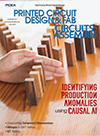Features Articles

Tricks to eliminate exposed copper.
This month we look at solder pad coverage. Some quality engineers still want to see solder coverage, regardless of the PCB surface finish. If they see the original surface coating, they become concerned, regardless of what is stated in IPC standards.
In the case of NiAu (FIGURE 1), it is most likely the solder paste will reflow and wet the pad toe area right up to the solder mask. In the case of an organic surface protectant (FIGURE 2), the solder paste will reflow successfully, wetting the termination and pad, forming a reliable joint. However, the solder may not reflow and wet any farther than the original print area on the OSP coating on the pad.
 Ask only for what you need for practical decision-making.
Ask only for what you need for practical decision-making.
Not a day goes by that I am not asked, or demanded, to provide volumes of data on what appear to be trivial things. Between DFARS flow-downs, NIST protocols, Dodd/Frank requirements and AS/ISO documentation, the verification and validation needs have reached hyper levels. But as time spent providing these data grows exponentially, I keep returning to two simple questions: Does the requester really know what they need? And is the information provided truly accurate?
We are a product of our experiences. My career commenced in the mid-1970s. Then, I was the “young pup,” the gofer and protegee to more seasoned coworkers. That was the era when businesses were just starting to adopt computers as management tools. The hot new area in every large corporation was the “Management Information Systems” department. They had the sexy new mainframe computers that took up the entire basement, typed code on snazzy keypads, and were able to generate reams of reports containing tons of data.
 Does artificial intelligence make you concerned for your job? Are humans at imminent risk of being replaced by robots, or even software-driven functions?
Does artificial intelligence make you concerned for your job? Are humans at imminent risk of being replaced by robots, or even software-driven functions?
Kyle Miller says no and no.
Miller is head of a team of product developers at Zuken in Bristol, England, that is working on AI-based place-and-route technology. In addition to the 20-plus years spent in CAD tools, he has a doctorate in artificial intelligence, which means he’s a lot better at math than me or you.
Speaking at Zuken Innovation World in mid-April, Miller outlined the headway Zuken is making in machine-learning tools. The short answer: quite a bit. Machine learning-based programs are very good at pattern recognition and converting data into usable forms. Everyday uses include Google’s Android-based speech-to-text tools. ML is also apparently superior in finding and exploiting bugs in software, to the extent the developers of the space-flight simulation role-playing game known as Elite Dangerous had to eliminate the function after their game’s ML exploited a glitch to create an unstoppable weapon.
Our Jan. 27 newsletter spoke about a decline from Taiwanese PWB manufacturers: “The barometer for the Taiwanese electronics industry is falling – signaling bad weather ahead.”
 If your designer certification were suddenly rendered invalid, would you feel any less professional? Would you feel any less knowledgeable about your craft?
If your designer certification were suddenly rendered invalid, would you feel any less professional? Would you feel any less knowledgeable about your craft?
Those questions are at the root of an ongoing debate between IPC and the Designer’s Council Executive Board. The two parties have been at odds over the past several months due to a difference in opinion over the nature of the certification program.
Designer certification as a formality dates back to 1994. A group of industry professionals, along with the late Dieter Bergman, then IPC technical director, devised the original template. (Disclosure: I was the IPC staff liaison for design and was present at all the meetings where the program was drafted.) A consulting firm we’d hired advised us to use a consensus body of knowledge such as a standard as the foundation for the exam, as it would leave us less exposed to litigation from someone who might have failed the test. Thus, we wrote hundreds of questions for a test based on IPC-D-275, the prevailing design standard of the time, but steeped in good design practice. And we developed a multi-day workshop to prepare designers for it.
Press Releases
- NEPCON ASIA 2025: Innovating Smart Manufacturing Ecosystems and Bridging Global Opportunities
- Viasion Technology Expands Global Reach as a Trusted PCB Manufacturer and EMS Provider in China
- Viasion Technology Expands Global Reach as a Trusted PCB Manufacturer and EMS Provider in China
- Nordson Test & Inspection Expands Partnership with Distributor smartTec Nordic A/S


